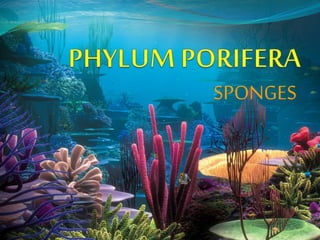
Introduction to Sponges: Characteristics, Types and Classification
- 1. SPONGES
- 2. Introduction Porifera (po-rif -er-a) (L. porus, pore, fera, bearing) Most primitive of all animals Among the approximately 15,000 sponge species are mostly marine; a few exist in brackish water, and some 150 species live in freshwater Sessile; Draws food and water into its body Figure 1. Some growth habits and forms of sponges.
- 3. Characteristics Multicellular Body with pores (ostia) where water, canals, and chambers that form a unique system of water currents on which sponges depend for food and oxygen Radial symmetry or none No organs or true tissues; digestion intracellular Excretion and respiration by diffusion
- 4. Has choanocytes, flagellated “collar” cells which help pump water in and out of the sponge Figure 2. Sponge choanocytes have a collar of microvilli surrounding a flagellum. Beating of the fl agellum draws water through the collar (blue arrows) where food is trapped on microvilli (red arrows).
- 5. Figure 3. Food trapping by sponge cells. A, Cutaway section of canals showing cellular structure and direction of water flow. B, Two choanocytes and C, structure of the collar. Small red arrows indicate movement of food particles.
- 6. Reactions to stimuli apparently local and independent in cellular sponges; Nervous system probably absent Asexual reproduction by buds or gemmules Sexual reproduction by eggs and sperm; free- swimming flagellated larvae in most Characteristics
- 7. 3 Types of Canal Systems Asconoid- simplest type among canal systems the choanocytes lie in a large chamber called the spongocoel
- 8. Syconoid- choanocytes lie in canals
- 9. Leuconoid- considered the major plan for sponges, for it permits greater size and more efficient water circulation.
- 10. Body wall with two layers of loosely arranged cells and a mesenchyme in between Body has an endoskeleton made up of spicules which can be calcareous, siliceous and spongin. Spongin Siliceous Calcareous
- 11. Classification
- 13. Class Calcarea (cal-care-a) (L. calcis, lime) (Calcispongiae). Have spicules of calcium carbonate that often form a fringe around the osculum (main water outlet); spicules needle-shaped or three or four rayed all three types of canal systems (asconoid, syconoid, leuconoid) represented ALL marine. Examples: Scypha, Leucosolenia, Clathrina. Calcareous Sponges
- 14. Scypha (Syconoid sponge) Marine; Usually found in shallow water Lives in fine detritus material and a variety of planktonic organisms in water Solitary sponge that may live singly or form clusters by budding Vase-shaped typically 1-3cm long with a fringe of straight spicules around the osculum
- 15. The soft body wall consists of 3 layers: thin flat cells which comprise the outer epidermis, the pinacocytes; inner lining of choanocytes; gelatinous mesohyl which bear undiffrentiated amoeboid cells, amoebocytes
- 16. Figure 4. Development of calcareous syconoid sponge, Scypha
- 17. Leucosolenia (Orange Pipe Sponge) small asconoid sponge grows in branching colonies usually arising from a network of horizontal, stolon like tubes
- 18. Clathrina (Yellow Network Sponge) Has similar characteristics with Leucosolenia but only differ with a kind of tube it has, an intertwined tube.
- 19. Class hexactinellida Have six-rayed, siliceous spicules extending at right angles from a central point spicules often united to form network body often cylindrical or funnel-shaped flagellated chambers in simple syconoid or leuconoid arrangement habitat mostly deep water; all marine. Example: Euplectella. Glass Sponges
- 20. Euplectella (Venus Flower Basket) They range from 7.5 cm to more than 1.3 m in length. Distinguishing feature: skeleton of six-rayed siliceous spicules bounded together into a network of glass-like structure. Tissues are syncytial network of fused amoeboid cells called a trabecular reticulum.
- 21. Class demospongea Common Sponges Contains 95 % of living sponge species including most large sponges Have siliceous spicules that are not six-rayed Spicules may be bound by spongin or maybe absent All members of the class are leuconoid and all marine except for members of freshwater family Spongillidae Examples: Carterispongia, Spongia.
- 22. Carterispongia (Elephant’s Ear Sponge) Shape like an expanded vase Its main body consists of a broad leathery plate Its skeleton is made up of only spongin and no spicules It has numerous ostia in its surface and root spicules for attachment to host
- 23. Spongia (Bath Sponge) Size frequently over 10 cm in diameter. Globular-massive, quite variable in shape. Oscules few in number, on the upper side, up to 1 cm in diameter. Consistency spongy- elastic, compressible, supple.
- 24. Figure 4. Development of common sponge, Demospongea
- 25. references Hickman, Cleveland Jr. P., et al. 2008 Integrated Principles of Zoology 14th ed. New York, USA. Mc-Graw Hill Companies, Inc.
- 26. Submitted by: Cacal, Brigitte Margaux Collera, Princess Faraon, Patricia Marie Francesca Lustado, John Marion Macanas, Clarissa (Group Rhinella marina)
